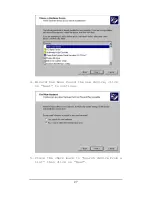
40
Most PCI/AGP video cards designed for Plug-n-Play, that means
video card IRQ’s setup which controls by main board’s (mother
board) circuitry and BIOS. Physically pulling out other devices
from system, and re-start the computer. Confirm and modify your
IRQ addresses with qualified computer technician.
Q:
Multiple images or unreadable screen after loading video driver.
A:
There are a variety of reasons why the display might be distorted.
One common reason is a monitor mismatch. Some older multi-
frequency monitors are unable to switch video modes without
being turned off, then turned on again.
If the problem occurring in windows, make sure that you have
loaded that proper video driver, and that the driver is compatible
with the monitor being used. Try re-configuring your application
software to use a compatible video mode. If problem persist in
windows, load the standard generic VGA driver. The generic VGA
driver should function properly with virtually every video board and
VGA (or SVGA) monitor available.
If that is an unsatisfactory solution, you may have to upgrade to a
monitor that support the desired video mode.
Some new monitors are also synchronizing this problem because
built-in DDC (Data-Digital-Channel) feature. Sometime that DDC
automatically setup the display frequency without loading video
driver. Try to turn it off, or change settings of monitor type in your
system.
Q:
Selection of color, resolution and refresh rate combination
that always back to default after restart the system.
A:
Accordingly, there must be a bug (defected source-code) in video
driver, or in the system. Debug the source-code or fix the error in
video driver, that should be done by the driver developer. Likewise,
upgrade the video driver from the manufacturer or from the original
software developer is necessary.
8.1 Tips
The following are some recommended steps to take if the video adapter
will not boot up or operate properly in your system:












































